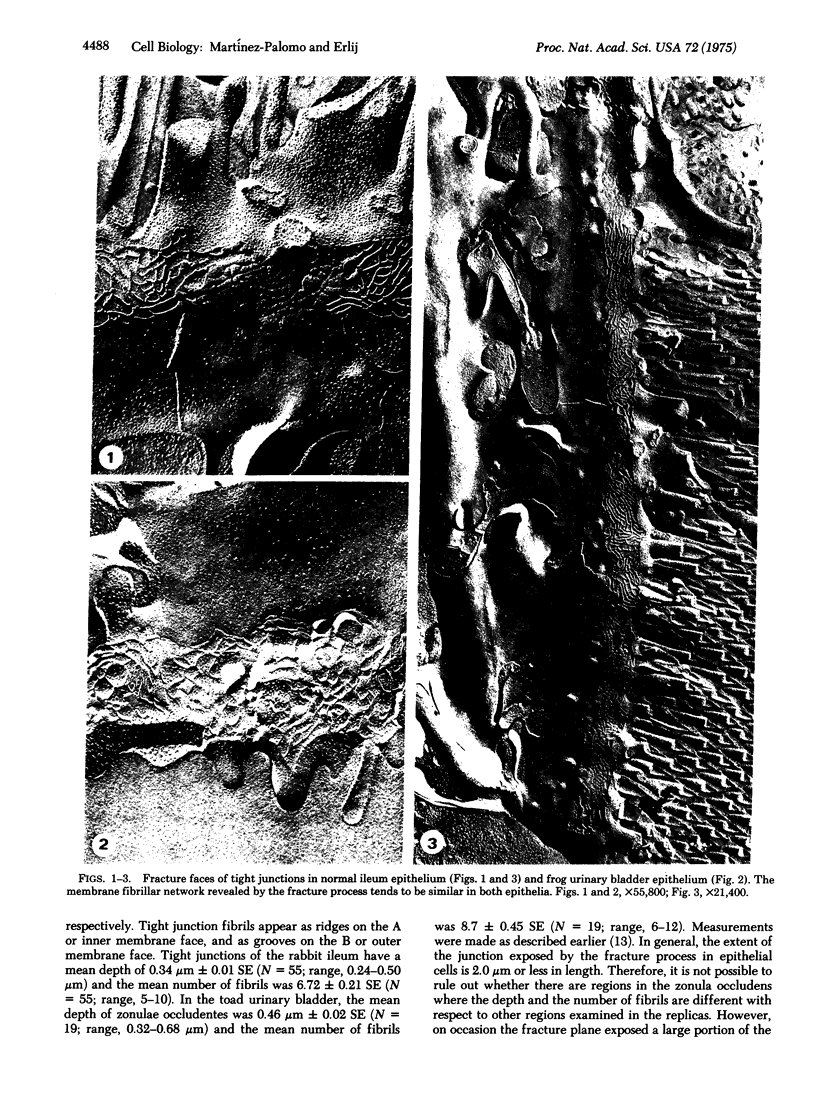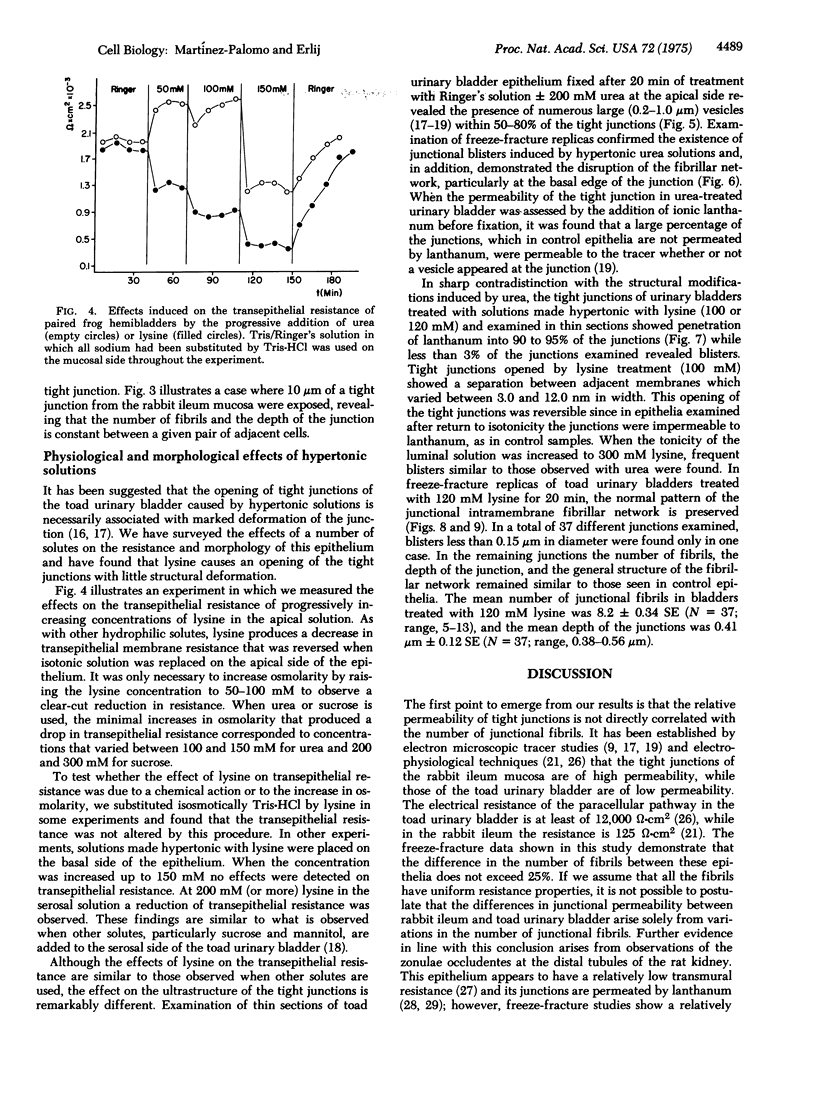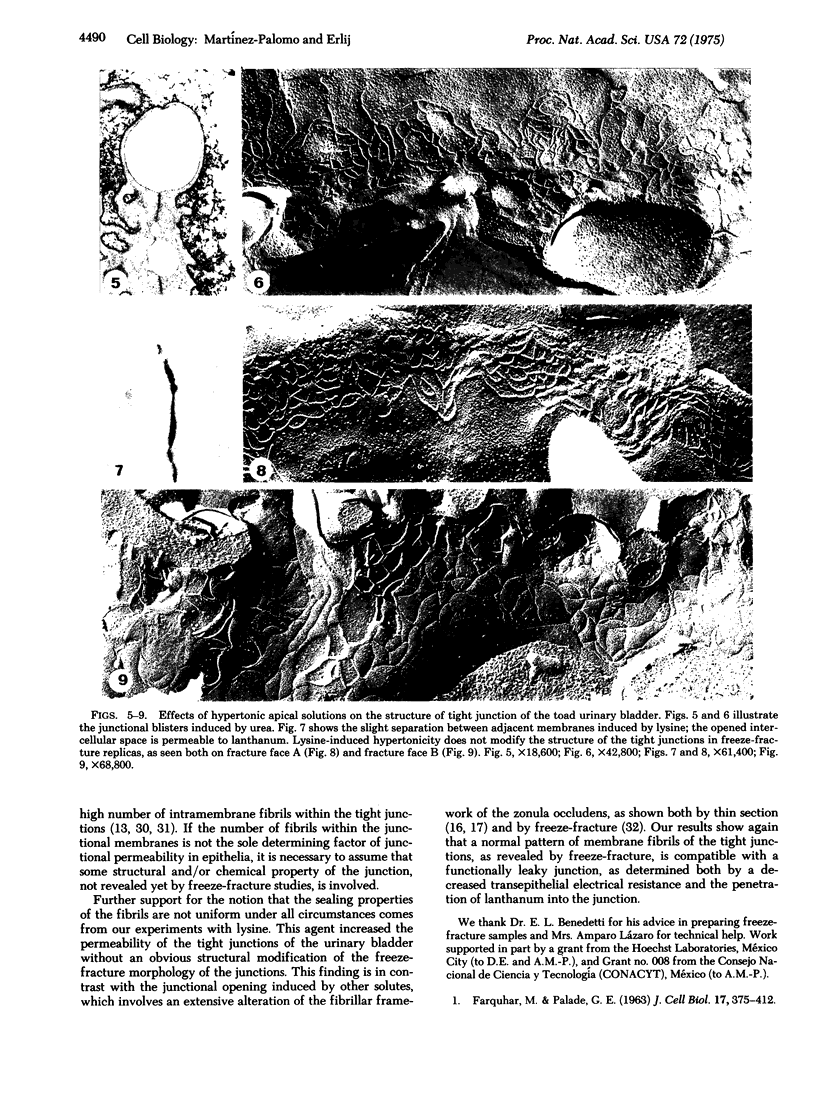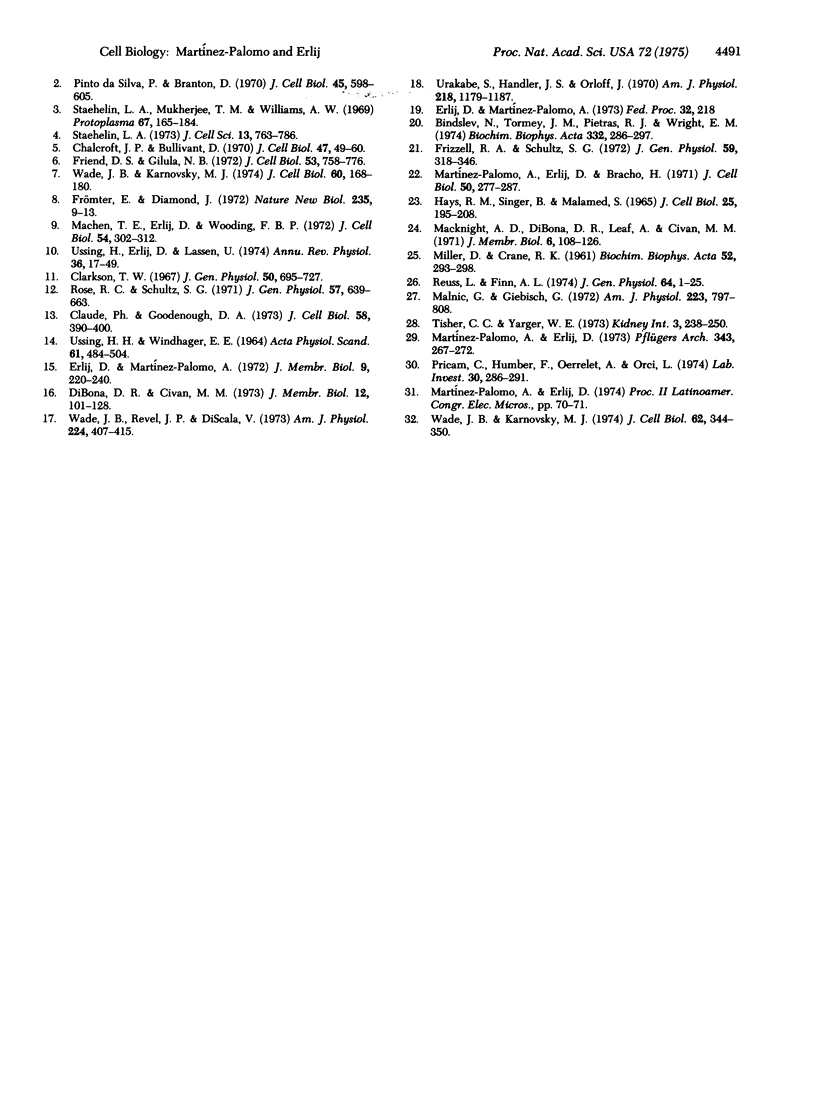Abstract
Freeze-fracture studies have shown a network of intramembrane fibrils in the tight junctions of epithelia. A direct correlation between the number of fibrils and junctional permeability has been suggested by previous studies. However, we have made two groups of observations showing that junctional permeability is not univocally related to the complexity of the network revealed by freeze-fracture. (i) The tight junctions of the rabbit ileum mucosa are permeable to lanthanum, although they have a complex network of fibrils resembling the junctions of toad urinary bladder, which are impermeable to lanthanum. (ii) The tight junctions of the toad urinary bladder are normally of low permeability; however, when the luminal solution is made hypertonic with lysine, junctional permeability markedly increases and lanthanum permeates through the tight junctions. In freeze-fracture replicas, no differences between the fibrils of control and lysine-treated bladders were found. Our results indicate that junctional permeability is controlled not only by the complexity of the fibrilar network, but that some features of the junctions or the fibrils themselves, not yet revealed by electron microscopy, play a central role in regulating epithelial permeability.
Full text
PDF




Images in this article
Selected References
These references are in PubMed. This may not be the complete list of references from this article.
- Chalcroft J. P., Bullivant S. An interpretation of liver cell membrane and junction structure based on observation of freeze-fracture replicas of both sides of the fracture. J Cell Biol. 1970 Oct;47(1):49–60. doi: 10.1083/jcb.47.1.49. [DOI] [PMC free article] [PubMed] [Google Scholar]
- Clarkson T. W. The transport of salt and water across isolated rat ileum. Evidence for at least two distinct pathways. J Gen Physiol. 1967 Jan;50(3):695–727. doi: 10.1085/jgp.50.3.695. [DOI] [PMC free article] [PubMed] [Google Scholar]
- Claude P., Goodenough D. A. Fracture faces of zonulae occludentes from "tight" and "leaky" epithelia. J Cell Biol. 1973 Aug;58(2):390–400. doi: 10.1083/jcb.58.2.390. [DOI] [PMC free article] [PubMed] [Google Scholar]
- DiBona D. R., Civan M. M. Pathways for movement of ions and water across toad urinary bladder. I. Anatomic site of transepithelial shunt pathways. J Membr Biol. 1973;12(2):101–128. doi: 10.1007/BF01869994. [DOI] [PubMed] [Google Scholar]
- Erlij D., Martínez-Palomo A. Opening of tight junctions in frog skin by hypertonic urea solutions. J Membr Biol. 1972;9(3):229–240. [PubMed] [Google Scholar]
- FARQUHAR M. G., PALADE G. E. Junctional complexes in various epithelia. J Cell Biol. 1963 May;17:375–412. doi: 10.1083/jcb.17.2.375. [DOI] [PMC free article] [PubMed] [Google Scholar]
- Friend D. S., Gilula N. B. Variations in tight and gap junctions in mammalian tissues. J Cell Biol. 1972 Jun;53(3):758–776. doi: 10.1083/jcb.53.3.758. [DOI] [PMC free article] [PubMed] [Google Scholar]
- Frizzell R. A., Schultz S. G. Ionic conductances of extracellular shunt pathway in rabbit ileum. Influence of shunt on transmural sodium transport and electrical potential differences. J Gen Physiol. 1972 Mar;59(3):318–346. doi: 10.1085/jgp.59.3.318. [DOI] [PMC free article] [PubMed] [Google Scholar]
- Frömter E., Diamond J. Route of passive ion permeation in epithelia. Nat New Biol. 1972 Jan 5;235(53):9–13. doi: 10.1038/newbio235009a0. [DOI] [PubMed] [Google Scholar]
- Hays R. M., Singer B., Malamed S. The effect of calcium withdrawal on the structure and function of the toad bladder. J Cell Biol. 1965 Jun;25(3 Suppl):195–208. doi: 10.1083/jcb.25.3.195. [DOI] [PMC free article] [PubMed] [Google Scholar]
- MILLER D., CRANE R. K. The digestive function of the epithelium of the small intestine. II. Localization of disaccharide hydrolysis in the isolated brush border portion of intestinal epithelial cells. Biochim Biophys Acta. 1961 Sep 16;52:293–298. doi: 10.1016/0006-3002(61)90678-3. [DOI] [PubMed] [Google Scholar]
- Machen T. E., Erlij D., Wooding F. B. Permeable junctional complexes. The movement of lanthanum across rabbit gallbladder and intestine. J Cell Biol. 1972 Aug;54(2):302–312. doi: 10.1083/jcb.54.2.302. [DOI] [PMC free article] [PubMed] [Google Scholar]
- Malnic G., Giebisch G. Some electrical properties of distal tubular epithelium in the rat. Am J Physiol. 1972 Oct;223(4):797–808. doi: 10.1152/ajplegacy.1972.223.4.797. [DOI] [PubMed] [Google Scholar]
- Martinez-Palomo A., Erlij D., Bracho H. Localization of permeability barriers in the frog skin epithelium. J Cell Biol. 1971 Aug;50(2):277–287. doi: 10.1083/jcb.50.2.277. [DOI] [PMC free article] [PubMed] [Google Scholar]
- Martínez-Palomo A., Erlij D. The distribution of lanthanum in tight junctions of the kidney tubule. Pflugers Arch. 1973 Oct 22;343(3):267–272. doi: 10.1007/BF00586049. [DOI] [PubMed] [Google Scholar]
- Pinto da Silva P., Branton D. Membrane splitting in freeze-ethching. Covalently bound ferritin as a membrane marker. J Cell Biol. 1970 Jun;45(3):598–605. doi: 10.1083/jcb.45.3.598. [DOI] [PMC free article] [PubMed] [Google Scholar]
- Pricam C., Humbert F., Perrelet A., Orci L. A freeze-etch study of the tight junctions of the rat kidney tubules. Lab Invest. 1974 Mar;30(3):286–291. [PubMed] [Google Scholar]
- Reuss L., Finn A. L. Passive electrical properties of toad urinary bladder epithelium. Intercellular electrical coupling and transepithelial cellular and shunt conductances. J Gen Physiol. 1974 Jul;64(1):1–25. doi: 10.1085/jgp.64.1.1. [DOI] [PMC free article] [PubMed] [Google Scholar]
- Rose R. C., Schultz S. G. Studies on the electrical potential profile across rabbit ileum. Effects of sugars and amino acids on transmural and transmucosal electrical potential differences. J Gen Physiol. 1971 Jun;57(6):639–663. doi: 10.1085/jgp.57.6.639. [DOI] [PMC free article] [PubMed] [Google Scholar]
- Staehelin L. A. Further observations on the fine structure of freeze-cleaved tight junctions. J Cell Sci. 1973 Nov;13(3):763–786. doi: 10.1242/jcs.13.3.763. [DOI] [PubMed] [Google Scholar]
- Staehelin L. A., Mukherjee T. M., Williams A. W. Freeze-etch appearance of the tight junctions in the epithelium of small and large intestine of mice. Protoplasma. 1969;67(2):165–184. doi: 10.1007/BF01248737. [DOI] [PubMed] [Google Scholar]
- Tisher C. C., Yarger W. E. Lanthanum permeability of the tight junction (zonula occludens) in the renal tubule of the rat. Kidney Int. 1973 Apr;3(4):238–250. doi: 10.1038/ki.1973.37. [DOI] [PubMed] [Google Scholar]
- USSING H. H., WINDHAGER E. E. NATURE OF SHUNT PATH AND ACTIVE SODIUM TRANSPORT PATH THROUGH FROG SKIN EPITHELIUM. Acta Physiol Scand. 1964 Aug;61:484–504. [PubMed] [Google Scholar]
- Urakabe S., Handler J. S., Orloff J. Effect of hypertonicity on permeability properties of the toad bladder. Am J Physiol. 1970 Apr;218(4):1179–1187. doi: 10.1152/ajplegacy.1970.218.4.1179. [DOI] [PubMed] [Google Scholar]
- Ussing H. H., Erlij D., Lassen U. Transport pathways in biological membranes. Annu Rev Physiol. 1974;36:17–49. doi: 10.1146/annurev.ph.36.030174.000313. [DOI] [PubMed] [Google Scholar]
- Wade J. B., Karnovsky M. J. Fracture faces of osmotically disrupted zonulae occludentes. J Cell Biol. 1974 Aug;62(2):344–350. doi: 10.1083/jcb.62.2.344. [DOI] [PMC free article] [PubMed] [Google Scholar]
- Wade J. B., Karnovsky M. J. The structure of the zonula occludens. A single fibril model based on freeze-fracture. J Cell Biol. 1974 Jan;60(1):168–180. doi: 10.1083/jcb.60.1.168. [DOI] [PMC free article] [PubMed] [Google Scholar]
- Wade J. B., Revel J. P., DiScala V. A. Effect of osmotic gradients on intercellular junctions of the toad bladder. Am J Physiol. 1973 Feb;224(2):407–415. doi: 10.1152/ajplegacy.1973.224.2.407. [DOI] [PubMed] [Google Scholar]




